
Posted by Live Yoga Life in Ayurveda, Diet on July 5th, 2010 10:00 am
Ayurvedic texts recommend the principle of opposites for reducing the level of a dosha that has become aggravated. Since the characteristics of Vata include dryness, coolness, roughness, lightness and constant motion, qualities that are opposite to these in diet and lifestyle help restore balance to Vata dosha.
Dietary recommendations – Vata Dosha
Include foods that are liquid or unctuous in your daily diet to balance dryness, some “heavy” foods to offer substance and sustained nourishment, foods that are smooth in texture to offset roughness and foods that are warm or hot to balance the cool nature of Vata. So what exactly does this mean in terms of foods you should choose and foods you should stay away from? Here are some specific dietary tips:
Suggested Food Choices for Vata dosha
The following list of suggested foods is by no means all-inclusive, but offers starting guidelines if you are new to ayurvedic dietary principles. We will add to this list regularly, so please check back often!
Grains: Rice, wheat, quinoa, oats, amaranth, all cooked until tender
Vegetables: Asparagus, tender greens, carrots, peas, green beans, white daikon, zucchini, lauki squash, parsnips, sweet potatoes, all cooked
Fruits: Avocado, pineapple, papaya, peaches, plums, grapes, mangoes, oranges, cherries, all kinds of berries, limes and lemons, apples if stewed, coconut, fresh figs, raisins (soaked)
Lentils: Mung beans, urad dhal, mung dhal, masoor dhal, toor dhal, red lentils, all cooked until butter-soft
Dairy: Whole milk, cream, butter, fresh yogurt (cooked into foods), lassi, cottage cheese, fresh paneer cheese
Oils: Ghee, olive oil, sesame oil, cold-pressed nut oils such as walnut
Herbs: Fresh ginger root, cilantro, curry leaves, parsley, fresh basil, fresh fennel, mint
Nuts and Seeds: Almonds (soaked and blanched), cashews, walnuts (soaked), pistachios, hazelnuts, pecans (soaked), pine nuts, sesame seeds, sunflower seeds, pumpkin seeds
Spices: Ajwain, dried ginger, asafetida (hing) in small quantities, fenugreek, turmeric, cumin, clove, cardamom, coriander, fennel, black pepper, basil, Chinese cinnamon, nutmeg, mustard seed, mint, rosemary, thyme, lemon and orange zest, oregano, rock salt or sea salt, black salt, dried mango powder, pomegranate seeds or powder
Other: Rice milk, soy milk, poppy seeds, sucanat, turbinado sugar, raw honey, and tofu in moderation (diced small and cooked with spices)
Lifestyle Recommendations: Balancing Vata dosha
Ayurvedic texts recommend the principle of opposites for reducing the level of a dosha that has become aggravated. Since the characteristics of Vata include dryness, coolness, roughness, lightness and constant motion, qualities that are opposite to these in diet and lifestyle help restore balance to Vata dosha.
Posted by Live Yoga Life in Yoga Poses on July 4th, 2010 9:41 pm
The Sun Salutation (Surya Namaskar) – which is also referred to as “Salute to the Sun” is a series of postures that you perform in a flowing sequence.
The whole sequence is coordinated with your breath. The basic approach is to inhale as you extend or stretch, and exhale as you contract or fold.
Some schools of yoga have their own variations of the Sun Salutation. The version below covers the core steps of a Sun Salutation A (Surya Namaskar A) which is the easier of the two main versions. It is typical of what you may experience in most Ashtanga Yoga or Vinyasa Hatha Yoga classes.
The benefits of this series of poses are that it is great as an effective warm-up practice, increases your flexibility and tones your all-important abdominal muscles.
There are two series of poses for the Sun Salutation. They are referred to as Sun Salutation A (Surya Namaskar A) and Sun Salutation B (Surya Namaskar B).
We offer the following range of high-quality yoga classes which include the Sun Salutation postures:
The following series contains the postures typically found in a Sun Salutation series. We have also added in several transitional poses to assist in transitioning between the main poses.
Tip: On days when you think you have no time for yoga, try and do at least one or two rounds of the Sun Salutation. You’ll feel the difference.
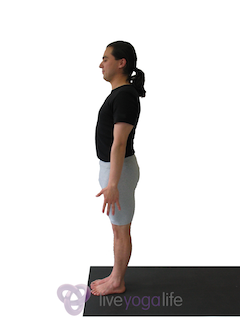 |
 |
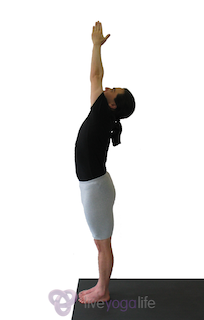 |
|
| Start in Mountain Pose (Samashti) – feet hip width apart, your weight evenly distributed, hands by your side | Raise your hands out to the side (inhale) | Continue until your palms are over head (Urdhva Hastasana) | |
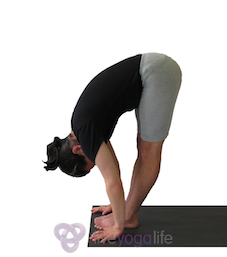 |
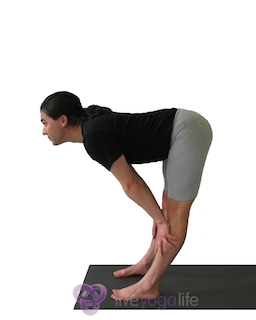 |
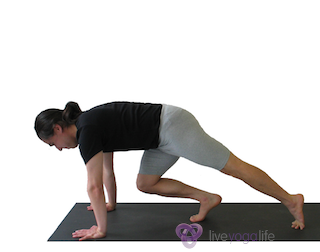 |
|
| Exhale as you fold forward into a standing forward bend (Uttanasana A) | Inhale into head-up forward bend (Uttanasana B) | Exhale and step one leg back | |
 |
 |
 |
|
| On the same inhale, continue to step the other leg back into Plank | Exhale into a low Push-Up (Chaturanga Dandasana) | Inhale into Upward-Facing Dog (Urdhva Mukha Svanasana) | |
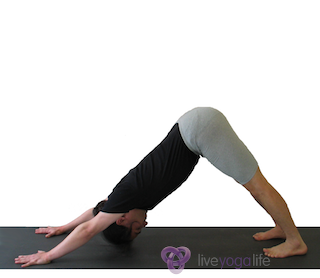 |
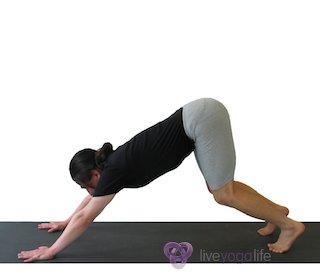 |
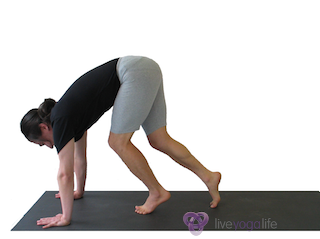 |
|
| Exhale into Downward Facing Dog (Adho Mukha Svanasna) | Inhale and bend your knees and look forward | Continue inhaling and walk one leg forward (or jump both feet to your hands if you are able to) | |
 |
 |
 |
|
| With both legs together, inhale as you move your hands out to the sides | Raise your palms over head (Urdhva Hastasana) | Exhale as you drop your arms by your side and stand in Mountain Pose (Samashti) |
Check out the following range of high-quality yoga classes which include the sun salutation poses:
Posted by Live Yoga Life in Ayurveda, Diet on July 3rd, 2010 12:34 pm
Balancing Pitta Dosha: Diet
Ayurvedic texts recommend the principle of opposites for reducing the level of a dosha that has become aggravated. Since the characteristics of Pitta include sharpness, heat, and acidity, qualities that are opposite to these in diet and lifestyle help restore balance to Pitta dosha.
Dietary recommendations
Include a few dry foods in your daily diet to balance the liquid nature of Pitta, some “heavy” foods that offer substance and sustained nourishment, and foods that are cool to balance the fiery quality of Pitta. So what exactly does this mean in terms of foods you should choose and foods you should stay away from? Here are some specific dietary tips:
Suggested Food Choices for Pitta dosha
The following list of suggested foods is by no means all-inclusive, but offers starting guidelines if you are new to ayurvedic dietary principles. We will add to this list regularly, so please check back often!
Grains: Rice, wheat, barley, oats, amaranth, sago, all cooked until tender
Vegetables: Asparagus, tender and bitter greens, bitter gourd, carrots, fennel, peas, green beans, zucchini, lauki squash, artichoke, parsnips, okra, celery, Brussels sprouts, broccoli, cauliflower, beets, sweet potatoes, all cooked, small quantities of raw lettuce, carrots or cucumber
Fruits: Avocado, pineapple, peaches, plums, grapes, mangoes, melons, pears, pomegranates, cherries, all kinds of berries, apples, coconut, dates, fresh and dried figs, raisins (soaked), all ripe and sweet
Lentils: Mung beans, mung dhal, red or brown lentils, small portions of garbanzos, lima beans, black beans, all cooked until butter-soft
Dairy: Whole milk, cream, butter, fresh yogurt (cooked into foods), lassi, cottage cheese, fresh paneer cheese
Oils: Ghee, olive oil, walnut oil
Herbs: Cilantro, curry leaves, parsley, fresh basil, fresh fennel, fresh mint
Nuts and Seeds: Almonds (soaked and blanched), sunflower seeds, pumpkin seeds
Spices: Turmeric, cumin, cardamom, coriander, fennel, small quantities of black pepper, Chinese cinnamon, mint, saffron, dill, sweet orange zest
Other: Rice milk, soy milk, sucanat, turbinado sugar, date sugar, and tofu in moderation (diced small and cooked with spices)
Balancing Pitta Dosha: Lifestyle
Ayurvedic texts recommend the principle of opposites for reducing the level of a dosha that has become aggravated. Since the characteristics of Pitta include sharpness, heat, and acidity, qualities that are opposite to these in diet and lifestyle help restore balance to Pitta dosha.
Lifestyle recommendations
Posted by Live Yoga Life in Ayurveda, Diet on June 28th, 2010 8:23 am
Ayurvedic texts recommend the principle of opposites for reducing the level of a dosha that has become aggravated. Since the characteristics of Kapha include heaviness, softness, sweetness, cold, stability and unctuousness, qualities that are opposite to these in diet and lifestyle help restore balance to Kapha dosha.
Dietary recommendations- Kapha Dosha
Include a few dry foods in your daily diet to balance the oily nature of Kapha, foods that are nourishing but light to counter the heaviness of Kapha and warm foods with a zing to them to balance the sweet, cold quality of Kapha. So what exactly does this mean in terms of foods you should choose and foods you should stay away from? Here are some specific dietary tips:
Suggested Food Choices for Kapha Dosha
The following list of suggested foods is by no means all-inclusive, but offers starting guidelines if you are new to ayurvedic dietary principles. We will add to this list regularly, so please check back often!
Grains: Buckwheat, quinoa, barley, millet, oats, amaranth, sago, small portions of Basmati rice, all cooked until tender
Vegetables: Asparagus, all kinds of greens, bitter gourd, green beans, lauki squash, artichoke, celery, Brussels sprouts, broccoli, cauliflower, beets, kohlrabi, daikon, radish, cabbage, all cooked
Fruits: Apricots, prunes, peaches, pears, cherries, berries, apples, lemons, limes, pomegranates, dried figs, raisins
Lentils: Mung beans, mung dhal, toor dhal, red or brown lentils, small portions of garbanzos, lima beans, black beans, all cooked until butter-soft
Dairy: Whole milk diluted with water, lassi, small portions of cottage cheese or fresh paneer cheese
Oils: Small portions of ghee and olive oil
Herbs: Cilantro, curry leaves, parsley, fresh basil, fresh mint, fresh oregano, fresh thyme, sage, neem leaves
Nuts and Seeds: Sunflower seeds, pumpkin seeds
Spices: Turmeric, cumin, cardamom, coriander, fennel, dried ginger, Chinese cinnamon, black pepper, Chinese cinnamon, mint, saffron, dill, lime zest, nutmeg, cayenne, fenugreek, mustard seed, oregano, marjoram, thyme, rosemary, paprika, mace, cloves
Other: Raw honey in moderation, unsalted unbuttered popcorn, crackers in moderation, cooked tofu in small quantities (diced small and cooked with spices)
Lifestyle recommendations: Balancing Kapha Dosha
Ayurvedic texts recommend the principle of opposites for reducing the level of a dosha that has become aggravated. Since the characteristics of Kapha include heaviness, softness, sweetness, cold, stability and unctuousness, qualities that are opposite to these in diet and lifestyle help restore balance to Kapha dosha.
Posted by Live Yoga Life in Ayurveda, Diet on June 23rd, 2010 6:00 am
What is Kapha?
Elements: Water and Earth – oily and heavy
Kapha is made up of the two elements water and earth.
Characteristics of Kapha dosha: heavy – both water and earth are heavy elements (guru); cold (sheetoha); soft (mridu); unctuous, offering lubrication (snigdha); sweet (madhura); stability, offering immunity (sthira); and slippery (tikshila).
People with more Kapha in their constitutions tend to be of larger proportions, with a robust frame and padded joints, thick smooth skin that may tend towards oiliness, and rich, wavy hair.
They are stable and calm in thought, speech and action, and are easy-going and supportive in relationships.
There is an element of steadiness to their step, a quality of serenity in their smile. Loyalty is usually their second name.
They are long, heavy sleepers and uncomfortable in damp, clammy environments. Calm and sweetness of disposition are hallmarks of balanced Kapha.
If your prakriti or original constitution has more Kapha in it, you will exhibit many of the characteristics and qualities of Kapha when you are in balance than people who have more Pitta or Vata in their make-up. And that’s natural. But if the qualities become extreme, or more pronounced than usual at a given time, then the Kapha in you has in all likelihood become aggravated or imbalanced, and needs to be brought back into balance.
Factors that can cause Kapha dosha to increase in the physiology include a diet that contains too many deep-fried, sweet or heavy foods, over-consumption of ice-cold foods or beverages, exposure to cold and damp, daytime sleep, and lack of exercise.
Signs that you need to balance Kapha:
If you answered yes to many of the questions above, following a Kapha-balancing diet and lifestyle can help restore balance to Kapha.
Posted by Live Yoga Life in Ayurveda, Diet on June 21st, 2010 6:00 am
Elements: Fire & Water – Hot & Liquid
What is Pitta?
Pitta is made up of the two elements fire and water.
Characteristics of Pitta dosha: hot and a little unctuous (sahasnehamushnam); sharp, burning (tikshnam); liquid and acidic (dravamlam); always flowing in an unbounded manner (saram); pungent and sharp (katuhu).
Pitta contains fire, but it also contains water. It is the source of the flame, but not the flame itself. Compare Pitta to gasoline–it is not hot to the touch, but it can be the source of flames.
People with more Pitta in their constitutions tend to be of medium proportions, with a frame that is neither petite nor heavy, warm skin that is very fair or ruddy and may be sensitive, and fine hair that tends towards premature graying or thinning.
They are sharp and determined in thought, speech and action. There is an element of purpose to their step, an intensity to their voice. Ambition is usually their second name.
They are moderate sleepers and gravitate towards cooler environments.
Self-confidence and an entrepreneurial spirit are hallmarks of balanced Pitta.
If your prakriti or original constitution has more Pitta in it, you will exhibit many of the characteristics and qualities of Pitta when you are in balance than people who have more Vata or Kapha in their make-up. And that’s natural. But if the qualities become extreme, or more pronounced than usual at a given time, then the Pitta in you has in all likelihood become aggravated or imbalanced, and needs to be brought back into balance. And if a predominantly Kapha or Vata person starts exhibiting many Pitta qualities, that indicates a Pitta imbalance in that Kapha or Vata body type. In both cases, it is then time to follow a Pitta-balancing diet and lifestyle to help restore the level of Pitta in the physiology to its normal proportion.
Factors that can cause Pitta dosha to increase in the physiology include a diet that contains too many hot or spicy foods, fasting or skipping meals, over-exposure to the sun or to hot temperatures, and emotional trauma.
Signs that you need to balance Pitta:
If you answered yes to many of the questions above, following a Pitta-balancing diet and lifestyle can help restore balance to Pitta.